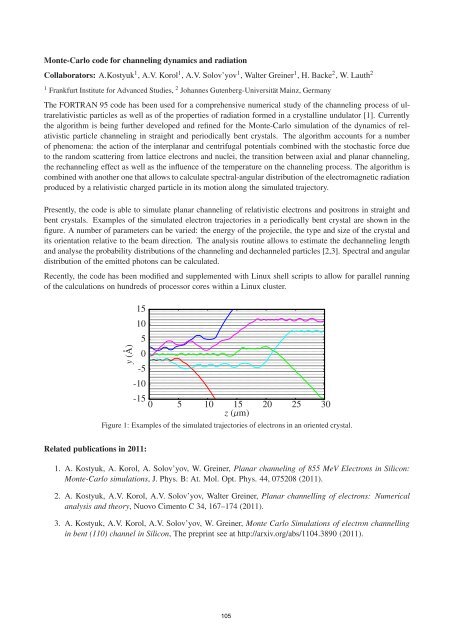FIAS Scientific Report 2011 - Frankfurt Institute for Advanced Studies ...
FIAS Scientific Report 2011 - Frankfurt Institute for Advanced Studies ...
FIAS Scientific Report 2011 - Frankfurt Institute for Advanced Studies ...
You also want an ePaper? Increase the reach of your titles
YUMPU automatically turns print PDFs into web optimized ePapers that Google loves.
Monte-Carlo code <strong>for</strong> channeling dynamics and radiation<br />
Collaborators: A.Kostyuk 1 , A.V. Korol 1 , A.V. Solov’yov 1 , Walter Greiner 1 , H. Backe 2 , W. Lauth 2<br />
1 <strong>Frankfurt</strong> <strong>Institute</strong> <strong>for</strong> <strong>Advanced</strong> <strong>Studies</strong>, 2 Johannes Gutenberg-Universität Mainz, Germany<br />
The FORTRAN 95 code has been used <strong>for</strong> a comprehensive numerical study of the channeling process of ultrarelativistic<br />
particles as well as of the properties of radiation <strong>for</strong>med in a crystalline undulator [1]. Currently<br />
the algorithm is being further developed and refined <strong>for</strong> the Monte-Carlo simulation of the dynamics of relativistic<br />
particle channeling in straight and periodically bent crystals. The algorithm accounts <strong>for</strong> a number<br />
of phenomena: the action of the interplanar and centrifugal potentials combined with the stochastic <strong>for</strong>ce due<br />
to the random scattering from lattice electrons and nuclei, the transition between axial and planar channeling,<br />
the rechanneling effect as well as the influence of the temperature on the channeling process. The algorithm is<br />
combined with another one that allows to calculate spectral-angular distribution of the electromagnetic radiation<br />
produced by a relativistic charged particle in its motion along the simulated trajectory.<br />
Presently, the code is able to simulate planar channeling of relativistic electrons and positrons in straight and<br />
bent crystals. Examples of the simulated electron trajectories in a periodically bent crystal are shown in the<br />
figure. A number of parameters can be varied: the energy of the projectile, the type and size of the crystal and<br />
its orientation relative to the beam direction. The analysis routine allows to estimate the dechanneling length<br />
and analyse the probability distributions of the channeling and dechanneled particles [2,3]. Spectral and angular<br />
distribution of the emitted photons can be calculated.<br />
Recently, the code has been modified and supplemented with Linux shell scripts to allow <strong>for</strong> parallel running<br />
of the calculations on hundreds of processor cores within a Linux cluster.<br />
y (Å)<br />
15<br />
10<br />
5<br />
0<br />
-5<br />
-10<br />
Related publications in <strong>2011</strong>:<br />
-15<br />
0 5 10 15 20 25 30<br />
z (µm)<br />
Figure 1: Examples of the simulated trajectories of electrons in an oriented crystal.<br />
1. A. Kostyuk, A. Korol, A. Solov’yov, W. Greiner, Planar channeling of 855 MeV Electrons in Silicon:<br />
Monte-Carlo simulations, J. Phys. B: At. Mol. Opt. Phys. 44, 075208 (<strong>2011</strong>).<br />
2. A. Kostyuk, A.V. Korol, A.V. Solov’yov, Walter Greiner, Planar channelling of electrons: Numerical<br />
analysis and theory, Nuovo Cimento C 34, 167–174 (<strong>2011</strong>).<br />
3. A. Kostyuk, A.V. Korol, A.V. Solov’yov, W. Greiner, Monte Carlo Simulations of electron channelling<br />
in bent (110) channel in Silicon, The preprint see at http://arxiv.org/abs/1104.3890 (<strong>2011</strong>).<br />
105
















